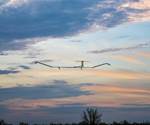Airbus, Salam join forces for HAPS connectivity services using composite Zephyr drone
The solar-powered, carbon-neutral unmanned aircraft system (UAS) will support and progress the development of digital connectivity in Saudi Arabia.
Zephyr, during its flight test campaign. Photo Credit: Airbus/Christian Otto 2021
’ (Toulouse, France) high altitude platform system (HAPS) Connectivity Business has signed a strategic partnership with (previously ICT), a Saudi Arabian telecommunications provider and part of the Mawarid Media & Communications Group (MMCG), to progress the development of private networks, Internet of Thing (IoT) applications, disaster management solutions and other connectivity and high-altitude Earth observation services from the stratosphere to serve the kingdom of Saudi Arabia.
Zephyr, a high-altitude unmanned aircraft system (UAS) drone, developed by Airbus in collaboration with the U.S. Army, is a solar-powered HAPS solution that will reportedly provide low-latency, direct-to-device 5G connectivity services, in addition to persistent high-resolution imaging and live-video, delivered from the stratosphere (see “Airbus successfully completes 2021 summer test flights for Zephyr HAPS satellite aircraft”). A wingspan of 82 feet and a carbon fiber composite fuselage enable it to carry payloads “of up to 50 pounds at altitudes of 70,000 feet.” Airbus believes that Zephyr will support in bridging the digital divide and will bring connectivity services to those who are currently unserved or underserved from a solar-powered and carbon-neutral platform.
“We see in Airbus’ Zephyr platform a key asset to provide private network services, IoT solutions as well as civil, governmental and non-governmental applications,” Ahmad Al-Anqari, Salam CEO, explains. “There are numerous use cases for the platform’s capabilities and we look forward to this partnership with Airbus to serve the Saudi market in support of the kingdom’s vision 2030 goals.”
Related Content
-
ASCEND program completion: Transforming the U.K.'s high-rate composites manufacturing capability
GKN Aerospace, McLaren Automotive and U.K. partners chart the final chapter of the 4-year, £39.6 million ASCEND program, which accomplished significant progress in high-rate production, Industry 4.0 and sustainable composites manufacturing.
-
Schrödinger advances materials informatics for faster development of next-gen composites
Cutting time to market by multiple orders of magnitude, machine learning and physics-based approaches are combined to open new possibilities for innovations in biomaterials, fire-resistant composites, space applications, hydrogen tanks and more.
-
IMDEA introduces digital twin for real-time analysis of composite materials production
Newly designed digital twin by IMDEA and Technical University of Madrid researchers enables manufacturers to see inside composite materials as they are being produced, facilitating early detection of faults.



